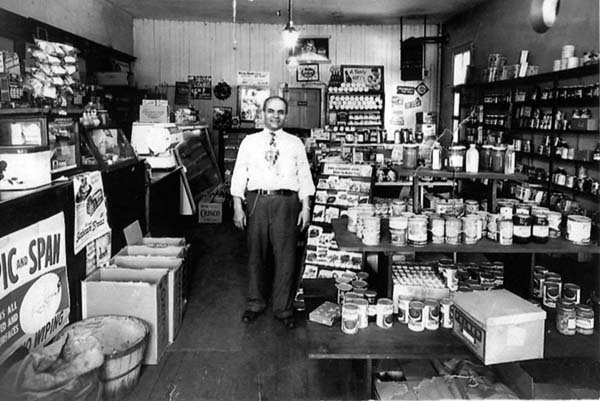Growing up on 7th Street
Recalling Parkersburg's East End
By Roger Nedeff

Syrian immigrant Moses Nedeff - the author's father - displays his wares at The Family Store, located at the corner of 7th and Swann streets, shortly after he opened the market in 1945.
In the 1950s and 1960s, I grew up on Swann Street, in a residential area of Parkersburg’s “rough East End.” It wasn’t an unfair reputation.
The East End dates back to the mid-1800s when the Baltimore and Ohio Railroad was completed into town. Many railroad workers settled in the East End, which was originally the terminus of the railroad until the Ohio River railroad bridge was completed in 1871. The workers, many recent immigrants, lived daily lives of hard manual labor. For some, their primary recreation was consuming alcohol, which fueled some epic brawls, fights, knifings, and murders. In his book Wood County, West Virginia in Civil War Times, H. E Matheny notes that the East End was called “The Bloody Sixth” due to its violence and location in the city’s sixth ward. In that book, Parkersburg resident Dr. C. J. Scott, who moved to Parkersburg in 1865, said, “There was a killing every now and then, especially at the corner of 7th and Lynn. . . . More men have been killed on that corner than in any place in the town.”
By the time I came along in 1954, the East End’s reputation hadn’t improved much. Larry Gibson, a former Parkersburg police chief, began his career as a beat cop in the district in 1961. A beat cop was a patrolman who walked a route through a neighborhood. Larry relates, “It was always exciting. I think at one time, there were 13 or 14 illegal gambling and liquor-by-the-drink joints from 7th and Green streets to 7th and George streets.”
My father emigrated from Syria in 1937. By 1945, he’d saved enough to purchase a brick building at the corner of 7th and Swann streets, where he opened up a small neighborhood grocery called The Family Store. He rented out the upper floors as apartments. In 1950, he purchased the house on Swann Street that my three brothers, three sisters, and I called home. A residence on East 8th Street Hill abutting my father’s building had a dilapidated stagecoach in the backyard. Susan, my older sister, recalls that everybody in the neighborhood, except me, played on it. I still like to tease Susan that she’s so old she used to play on a stagecoach!
The boundaries of the East End’s business district ran roughly from 13th Street West to Avery Street along U.S. 50, or 7th Street. The residential areas were the numerous side streets that intersected with 7th Street. Parkersburg’s East End was like a village in its own right. There was no need to go downtown because everything you needed was readily available.
There was the Coliseum Skating Rink and Bowling Alley, where we skated for 25 cents on Sunday afternoons. Parkersburg Creamery had every dairy delight one could imagine, and at Greiner’s Bakery, you could buy day-old bread for seven cents a loaf—three cents cheaper than the fresh bread. The Sheik Restaurant and Cafe, The Palace theatre, East End Drug Store, Arcade TV and Appliance, Kesterson Ice Plant, Berdine’s Produce, and Aston Motorcycle Shop were well-known East End businesses. Scattered throughout was an array of used car lots and, of course, the district’s primary businesses: taverns—or beer joints, as we referred to them—and clubs where liquor was often sold illegally.
The East End had a unique and diverse character that I loved, even as a small boy. The Angelos from Greece had a restaurant and soda fountain. Mr. Angelos was famous for his chocolate creations at Easter time. He’d make the most detailed and elaborate eggs, hens, and rabbits from chocolate. It was almost a sin to eat these works of art.
Two African-American men, Bill Waldon and Emmanuel “Bud” Robinson, had barber shops in the East End. Bud was deaf. We used a stenographer’s pad to tell him what type of haircut we wanted. We boys knew we’d come of age when Bud brought out the straight razor to do the final trimming on the backs of our necks and around our ears.
Two branches of the Thomas family, who, like us, were Syrian, had car lots on 7th Street. The residential area was a mix of whites, blacks, and various nationalities, including Syrians and Italians, blue-and-white collar workers, Catholics, Protestants, and a few Jewish families.
You can read the rest of this article in this issue of Goldenseal, available in bookstores, libraries or direct from Goldenseal.